BY LETTER
Extended World Classification System (EWoCS)
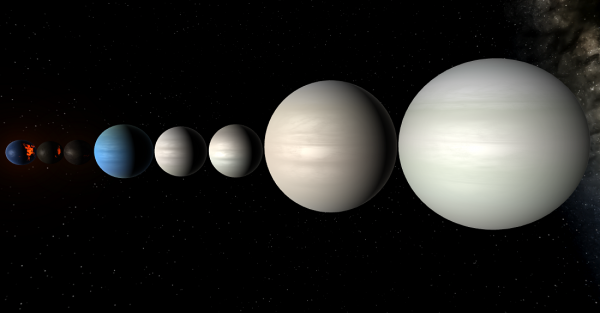 Image from Dangerous Safety | |
| Kepler 90, a system containing terrestrial, superterrestrial, neptunian and jovian worlds | |
COMPOSITION: Categories
The bulk composition of planets varies significantly, but the components are divided into several major groups; Gases (specifically Hydrogen and Helium) Volatiles (ices such as water, ammonia, solid nitrogen) Siderophilic elements (chiefly iron), and a wide range of atmospheric gases other than H/He. Also significant is the ratio between carbon and oxygen- worlds and systems that are oxygen-rich are dominated by oxidised rocks, while systems that are carbon-rich have more carbide-type minerals.H2/He GASES
Worlds categorised by H/He content- Jovian (gas giants) Worlds mostly hydrogen and helium by mass. Examples - Jupiter, Lippershey
- Neptunian (ice giants) Hydrogen and helium make up 0.1-50% of the world by mass. Examples - Neptune, Skoll
- Terrestrial (NoLWoCs category Terrestrial worlds) Less than 0.1% of the total mass comes from hydrogen or helium. Examples - Earth, Luna, Seattle.
VOLATILES
Worlds categorised by ice content (water ice, ammonia ice, etcetera)- Ymirian Volatiles contribute more than 67% to the solid mass of the object. Examples - Neptune, Rhea, Iapetus
- Gelidian 33-67% Volatiles by mass. Examples -Eris, Ganymede, Pluto
- Cerean 1-33% volatiles by mass, excluding H/He. Examples - Europa, Ceres, Tartarus.
- Lapidian Volatiles contribute less than 1% to the non-gaseous mass. Examples - Earth, Mercury
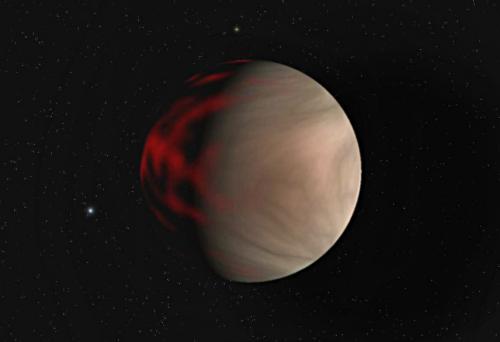 Image from Steve Bowers | |
| Janssen, a hot carbon-rich superterrestrial in the 55 Cancri system | |
C/O RATIO
Worlds categorised by carbon/oxygen ratio- Carbonic (NoLWoCs category Adamean) Worlds with enough excess carbon to form a graphite or diamond rich crust. C/O above 10 Example - Solaris.
- Carbidic Worlds dominated by carbide minerals, with small amounts of carbonates. C/O ratio between 1 and 10. Examples - Janssen, Sisyphos
- Carbonatic Worlds with a blend of carbonate, oxide, and carbide minerals. C/O ratio between 0.1 and 1. Examples -Jupiter, Neptune
- Oxidic Worlds dominated by oxide minerals and/or oxygen rich volatiles, C/O ratio less than 0.1. Examples - Earth
CORE
Worlds categorised by core (siderophile) fraction- Ferrinian Siderophile metal core more than 80% of its non-volatile mass. Examples -Bernal, Singapore
- Hermian Siderophile metals make up 50-80% of the non-volatile mass. Examples - Mercury, Aglaea, 16 Psyche
- Telluric Worlds with metal core fractions between 15% and 50%. Examples -Earth, Mars, Io, Vesta
- Selenian Siderophile metals make up 0-15% of the non-volatile mass. Examples -Luna, Thalia, 7 Iris
ATMOSPHERIC COMPOSITION
Worlds categorised by atmospheric composition- Jotunnian Hydrogen-dominated atmosphere Examples - Neptune, Jupiter, Vert
- Helian Helium-dominated atmospheres Example - Kepler-10c
- Ydratian Atmospheres dominated by simple hydrides (CH4, NH3, H2O, HF) Examples -Trappist-1b, Sarustre, Tyr
- Rhean Atmospheres dominated by diatomic non-metals (N2, O2, F2) Examples -Earth, Titan, Mercury
- Minervan Atmospheres of other non-metal compounds (CO, CO2, SO2, NO2, HNO3, CS2, HCN) Examples - Venus, Mars, Io
- Hephaestian Metal and metalloid compound atmosphere (SiO2, MgO, FeO, NaCl, Na, Fe) Examples - Janssen, Ixion
- Edelian Atmospheres dominated by other noble gases Examples - Luna, Skeblu
AEROSOLS: Categories
The importance of aerosols in the visual characteristics of planets
The appearance of worlds with thick atmospheres is entirely dominated by the amount, composition, and distribution of its atmospheric aerosols. Such worlds are classified on whether they are cloudy (Nubian), hazy (Catachian), or cloudless (Azurian).The temperature of the troposphere, at ~0.1 bar, is also used to classify these worlds into four temperature categories: Cryothermal, <90 K; Mesothermal, 90-500 K; Pyrothermal, 500-1300 K; and Hyperpyrothermal, >1300 K. The hyperpyro- and pryo- classes lineup with L and T type brown dwarf temperatures respectively. Within the hyperpyro temperature class, the inclusive "Epistellar" subcategory is sometimes used to refer to worlds hotter than 2200 Kelvin, the minimum temperature for M type stars.
Aerosol types
Arranged by increasing temperature:Cryothermal :: Less than 90k :: Cold worlds at the edge of solar systems, and in deep space
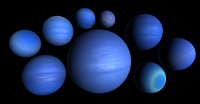 Image from Dangerous Safety | |
| CryoAzurian worlds | |
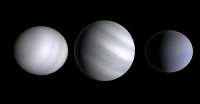 Image from Dangerous Safety | |
| Frigidian Worlds | |
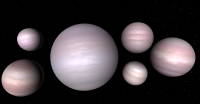 Image from Dangerous Safety | |
| Neonean worlds | |
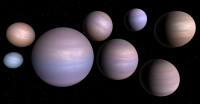 Image from Dangerous Safety | |
| Borean worlds | |
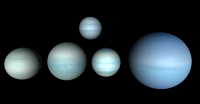 Image from Dangerous Safety | |
| Methanean worlds | |
Mesothermal 90-500K Worlds in the midmost parts of solar systems
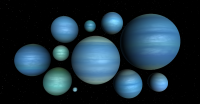 Image from Dangerous Safety | |
| MesoAzurian worlds | |
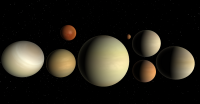 Image from Dangerous Safety | |
| Tholian Haze | |
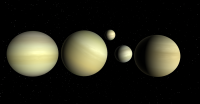 Image from Dangerous Safety | |
| Sulfanian worlds | |
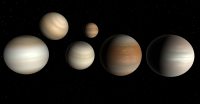 Image from Dangerous Safety | |
| Ammonian worlds | |
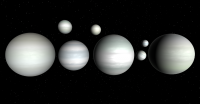 Image from Dangerous Safety | |
| Hydronian worlds | |
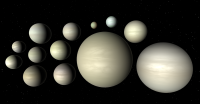 Image from Dangerous Safety | |
| Acidian worlds | |
Pyrothermal 550-1400K Hot worlds near the local star
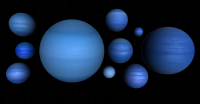 Image from Dangerous Safety | |
| PyroAzurian Worlds | |
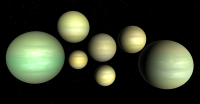 Image from Dangerous Safety | |
| Sulfolian Worlds | |
Image from Dangerous Safety | |
| Silicolean Worlds | |
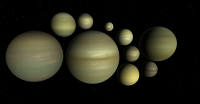 Image from Dangerous Safety | |
| Chloridian Worlds | |
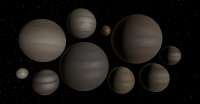 Image from Dangerous Safety | |
| Alkalinian worlds | |
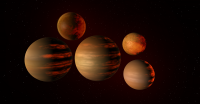 Image from Dangerous Safety |
Hyperthermal :: More than 1400K :: Very Hot worlds very near the local star :: Planets in this group are luminous in visible wavelengths, making the aerosol colors difficult to observe
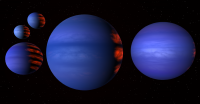 Image from Dangerous Safety | |
| Hyperpyroazurian worlds | |
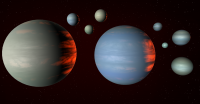 Image from Dangerous Safety | |
| Enstatian worlds | |
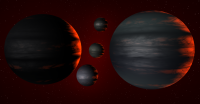 Image from Dangerous Safety | |
| Rutilian worlds | |
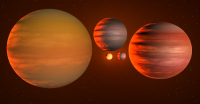 Image from Dangerous Safety | |
| Refractian worlds | |
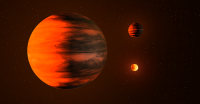 Image from Dangerous Safety | |
| Carbean worlds | |
- EpistellarAzurian :: 2200K+ :: Aerosols - none :: Ultrahot subset of HyperpyroAzurian worlds (atmospheric colours on these worlds are subsumed by thermal luminosity) :: Examples -Kelt-9b
- Aithalian 2600-3400K :: Aerosols:carbon :: Moderate haze of fullerenes and other carbon allotropes. (Atmospheric colours on these worlds are subsumed by thermal luminosity)
Comments on the aerosol/cloud/haze categories.
- Aerosols become far less apparent below pressures of approx 0.1 bar, and are often excluded in these cases.
- Non-cloud types (Hazes, Smoke, Soot, Dust, etc.) are denoted by the use of italics, and are less easily visible than clouds, especially at high temperatures.
- Azurian typings require atmospheric pressures above approx 40 bar.
- Clouds at high temperatures may vary significantly.
- Cloud colors are only approximate, chemical impurities, stellar temperatures, and the balance between internal and external heating may have significant effects on the appearance of these worlds.
TERRESTRIAL WORLDS -Categories
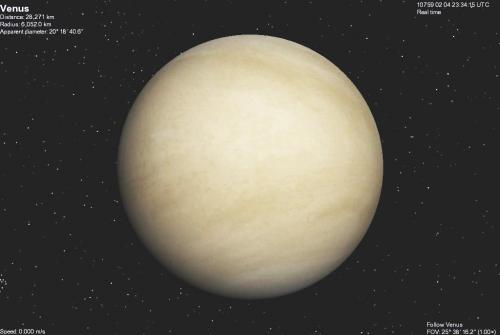 Image from Steve Bowers | |
| Venus, a Cytherean type world | |
- Gaian Earth-like worlds with liquids present on the surface. Examples - Earth, Elmo, Glim
- Abyssal Gaian worlds with compressible liquids (supercritical pressures and subcritical temperatures) at the surface.
- Thalassic (Panthallasic) Gaian ocean worlds, with high pressure ices well above the critical pressure covering a deep seafloor. For a world with Earth-level gravity, this corresponds to a depth greater than 10km. Examples - Panthalassa, Blue, Donbetyr, Janssen
- Tohulian Terrestrial worlds with a supercritical fluid layer atop surface liquids. The supercritical fluid and liquid are different species. Example - Tohul
- Calidian Worlds with atmospheres primarily in the vapor phase. The vapor atmosphere and liquid do not have to be the same species. Example - Titan. Ixiion
- Cytherean Venus-like worlds with a supercritical fluid layer above a solid surface. The upper atmospheres of these worlds often host virga precipitation, which evaporates before reaching the surface. Supercritical fluid does not have to be the dominant component of the atmosphere and can make up as little as a few percent of the atmosphere.Example - Venus, Blanchard, Sarustre
- Muspellian Cytherean worlds with high pressure ices coating the surface. The ice is of the same species as the supercritical atmosphere. Fairly rare as temperature pressure profiles make solids difficult. Pressures at "surface" usually in excess of 100 kbar. Example - Atlas
- Europan Europa-like worlds with a subcrustal hydrosphere. Surface interactions, when present, more closely resemble techtonic activity than conventional meteorology. Examples - Europa, Ceres, Dione
- Ganymedean icy worlds with high pressure ices below a subcrustal hydrosphere. Examples - Ganymede, Callisto
- Phlegethean Europan worlds with subsurface supercritical fluids More likely to occur on larger worlds with greater internal heating.
- Agonian Worlds with gaseous atmospheres above the triple pressure and lacking any liquids or supercritical fluids on or below the surface. Example- Pasithia
- Arean (NoLWoCs class Arean) Mars-like worlds with surface pressures below the triple point of their atmosphere, but above 0.1 nanobar. Deposition and sublimation occurs directly between the surface and atmosphere, with minimal cloud and haze formation. Examples - Mars, New Mars
- Chionian [Arean] Arean worlds with an extensive surface cryosphere which undergoes plastic flow in glacial cells. Basal melt from under the cryosphere can be transported to the surface through a subsurface fluid table. Examples - Pluto, Triton
- Apnean Airless worlds with surface pressures below 0.1 nanobar [10E-5 Pa]. Examples - Luna, Mercury
Terrestrial Temperature categories
- Thermal Too hot for any frozen precipitation to reach the surface. Typically very humid. Example - Tohul
- Tepidal Temperatures low enough for snow and ice, but not for permanent accumulation in ice caps. Example - Trees. Earth has been Tepidal several times in the past
- Tundral Permanent accumulation of snow and ice in glaciers and ice caps. Examples - Earth, Mars, Pluto
- Glacial Global temperatures well below the freezing/deposition point Example - Triton
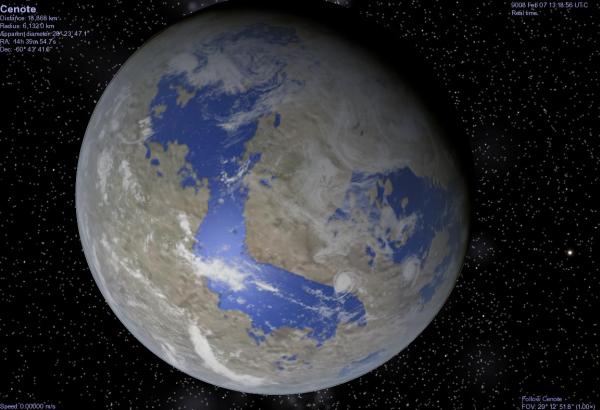 Image from Steve Bowers | |
| Cenote, a Campian Gaian world | |
Terrestrial Surface Liquid Coverage categories
- Pelagic More than 90% of the surface is covered by liquid. Example - Pacifica
- Marine Between 60% and 90% of the surface is covered by liquid, often as a single interconnected body. Examples - Earth, Trees
- Estuarine; Campian Between 40% and 60% of the surface is covered by liquid. Examples - Tohul, Nova Terra
- Lacustrine Between 10% and 40% of the surface is covered by liquid, often shallow isolated bodies. Examples — Samael
- Conlectic; Xeric less than 10% of the surface is covered by liquid. Example - Titan
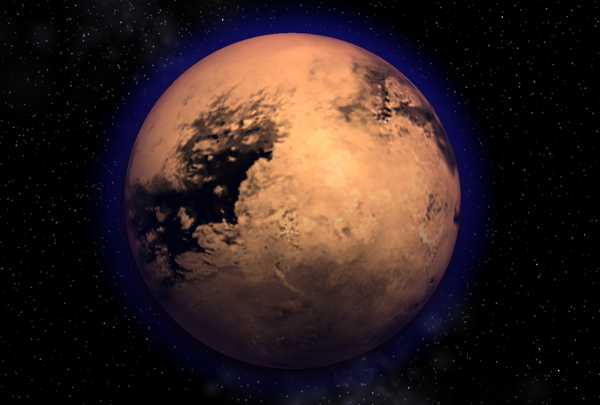 Image from Steve Bowers | |
| The ethane seas of Titan | |
Terrestrial Worlds - Fluid categories
- Aquatic (prefix-Aqua) Water One of the most abundant fluids. As a liquid, it is usually pure or nearly pure. It is commonly a base solvent for other rarer fluids, most notably ammonia. Examples - Earth, Europa, Enceladus
- Titanian (prefix-Titano) Methane, Ethane . Usually methane and/or ethane with a sugificant amount of propane (1-10%). Other short alkanes and organic compounds are also commonly found in trace amounts. Example Titan
- Capnian (prefix-Capno) Carbon Dioxide Requiring greater than 5.2 bars to form a liquid, it primarily forms on arean or cytherean worlds.
- Azotian (prefix-Azo) Liquid nitrogen seas. Common on very cold icy bodies in arean environments. High pressure azocytherean worlds are also common, but nitrogen is rarely the dominant atmospheric species. Low pressures as a result of atmospheric condensation make surface hydrospheres rather rare. Example - Pluto
- Monoxian (prefix-Monoxo) Carbon Monoxide More common in carbon rich systems. Often found on arean and cytherean worlds.
- Petrolic (prefix-Petro) Petroleum Various hydrocarbons and organic compounds, with a composition comparable to crude oil. Can be enriched in alcohols and other organic compounds. Examples - Uwa Mmanu, Solaris
- Bitumic (prefix-Bitumo) Bitumen High temperature version of Petrolic worlds, where the shorter and more volatile compounds have boiled off leaving long asphaltenes and paraffins. Con contain significant quantities of sulfur and organosulfur compounds.
- Alcoholian (prefix-Alco) Alcohols Primarily methanol and ethanol. Is miscible with a variety of other compounds, most notably water, ammonia, and octane.
- Igneous (prefix-Igneo) Magma; Metal Oxides Non-volatile metal compounds. SiO2, MgO, FeO, as well as metallic iron are most common.
- Salific (prefix-Salifo) Metal Salts Most commonly NaCl, KCl, and NaSO4. Can also be found with metal sulfides.
- Odorian (prefix-Odo) Hydrogen Sulfide Common on cold sulfur rich worlds. Frequently occurs in conjuction with ammonia, forming ammonium hydrosulfide.
- Phosphanic (prefix-Phosphano) Phosphine Rare continuum usually found in solution with methanol.
- Risian (prefix-Risi) Nitrogen Oxides Nitrogen Dioxide and/or Dinitrogen Tetroxide are the most common species.
- Ionean (prefix-Io) Sulfur Oxides Uncommon cold typically arean worlds. May occur alongside carbon dioxide in cytherean and agonian worlds, but very rarely dominates the atmosphere. Example - Io
- Prussic; Cyanic (prefix-Prusso; Cyano) Hydrogen Cyanide Sometimes occuring in place of ammonia on carbon rich worlds.
- Vitriolic (prefix-Vitrio) Sulfuric Acid Though relatively common as virga on cytherean and agonian worlds, it is far rarer as a surface liquid, and usually in a dilute aqueous solution. Intermediate concentrations (15-75%) are rarer than high concentration solutions due to azeotropic mixing at 98%. Examples - LiuShan, Xanthippe
- Phosphoric (prefix-Phospho) Phosphoric Acid Similar to sulfuric acid, it is extremely rare for it to be found as a surface liquid. It is usually in aqueous solutions of less than 46% H3PO4.
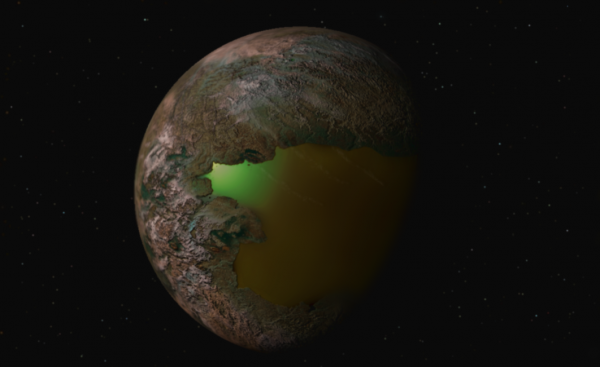 Image from Steve Bowers | |
| The ammonia seas of Samael | |
- Amunian (prefix-Amuno) Ammonia One of the most common fluids. It is typically found in conjuction with water as a dihydrate solution (5-33%) in Europan environments. Surface fluids are less frequent, but still rather common. Example - Samael
- Carbonylic (prefix-Carbonylo) Metal Carbonyls Rather uncommon, due to the rarity of cold metallic worlds. Primarily Iron Pentacarbonyl, with traces of Nickel Tetracarbonyl.
- Nitric; Fortic (prefix-Forto) Nitric Acid Primarily in an aqueous, or less commonly ammonious solution. Rarely found in concentrations above 70%
- Formamian (prefix-Forma) Formamide Predominantly found with ammonia and/or formic acid, but can be found in isolation. HCN, CH3OH, and H2O are also common. Example - Shona
- Brimstonian (prefix-Brimo) Sulfur Frequently occurs on active sulfur rich worlds, but is usually superceded by more abundant continuums. It can be found with organosulfur compounds and metal sulfides.
- Neonic (prefix- Neono) Neon Ambient interstellar temperatures and internal heating can prevent neon condensation, making it rare even among Stevensonian worlds.
- Hydrochloric (prefix-Chloro) Hydrogen Chloride Primarily form in aqueous solution from biological processes in chlorine enriched worlds, as abiologic routes are much more restrictive. Highly concentrated hydrogen chloride is extremely rare as a surface liquid. Example - Chorus
- Hydrofluoric (prefix-Fluoro) Hydrogen Fluoride They are likely to form in a similar manner to Hydrochloric worlds, though no definitive natural examples of either aqueous hydrofluoric acid, or pure hydrogen fluoride worlds are known.
SIZE: Categories
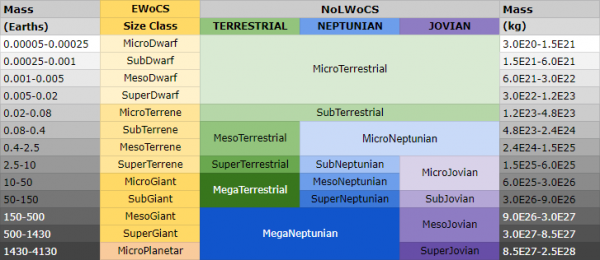 Image from Dangerous Safety | |
| EWoCs size categories compared to those used by the NoLWoCs system | |
Planetesimals (smaller asteroids)
- Microplanetesimal less than 10 million tons
- Subplanetesimal more than 10 million tons - Example - 101955 Bennu
- Mesoplanetesimal more than 10 billion tons Rubble pile and solid body abundance crossover. Examples - Phobos, Deimos
- Superplanetesimal more than 10 trillion tons Too small to have undergone differentiation, unless a fragment of a larger body. Examples - Elara, Pandora
- Microplanetoid more than 0.0000002 x Earth mass May have formed a partially differentiated interior. Examples - Hyperion, Amalthea, Janus
- Subplanetoid more than 0.000001 x Earth mass Hydrostatic equilibrium may have occured in the past, resulting in a rounded shape. Examples - Psyche, Iris, Phoebe
- Mesoplanetoid more than 0.000005 x Earth mass Examples - Miranda, Proteus, Mimas
- Superplanetoid more than 0.000013 x Earth mass Highest mass bodies that might never have been in Hydrostatic equilibrium. Examples - Varda, Vesta, Pallas
- Microdwarf more than 0.00005 x Earth mass Lowest mass possible to maintain Hydrostatic equilibrium after formation. Examples - Quoar, Ceres, Varuna
- Subdwarf more than 0.00025 x Earth mass - examples Titania, Rhea, Makemake
- Mesodwarf more than 0.001 x Earth mass. Examples - Triton, Pluto, Eris
- Superdwarf more than 0.005 x Earth mass. Examples - Io, Luna, Europa.
- Microterrenes more than 0.02 x Earth mass. Too large to fall out of hydrostatic equilibrium. Geologically active for 10s to 100s of millions of years. Examples - Mercury, Ganymede, Titan
- Subterrenes more than 0.08 x Earth mass. Likely sustained geotectonic activity for around a billion years after forming. Examples - Mars, Bernal, Nemec
- Mesoterrenes more than 0.4 x Earth mass. Can maintain H/He envelopes. Sustained geotectonics are possible. - examples Venus, Earth, Samael
- Superterrenes (NoLWoCs class Superterrestrials) more than 2.5 x Earth mass Tectonic plates become increasingly unlikely in rocky worlds. Examples - Janssen, Seattle, Tartarus.
- Microgiant more than 10 x Earth mass Largest bodies capable of lacking any H/He envelope. Examples - Uranus, Neptune, Iolus
- Subgiant more than 50 x Earth mass. Past runaway gas accretion, but not massive enough to compress it well. Examples - Saturn, Brahe, Smertrios
- Mesogiant more than 150 x Earth mass. Examples - Jupiter, Galileo, Hera
- Supergiant (NoLWoCs class SuperJovian) more than 1430 x Earth mass. Radius decreases with mass. Examples - Lippershey, Saffar
Objects larger than 13 Jupiter masses are classified as Brown Dwarfs (q.v)
ORBITAL and MISCELLANEOUS CATEGORIES
- Oculan Type Worlds Worlds/Vesperian Type Worlds that are tidally locked (includes Vesperian and Polyphemian worlds) More information here.
- Stevensonian Type Worlds Worlds that are found in interstellar space More information here.
- Skolian Type Worlds Worlds with axial tilts greater than 45 degrees; any class of world can have Skolian characteristics. More information here.
- Janusian Type Worlds Worlds in resonant orbits which regularly exchange momentum. More Information here.
- Ikarian type worlds Worlds with eccentric orbits, with an eccentricity greater than 0.35. Any class of world can have an Ikarian type orbit. More Information here.
- Dioscuran type worlds Binary Planets, with she smaller world no less than 0.1x the mass of the larger world
- Phoenixian worlds: worlds orbiting pulsars, neutron stars, black holes or white dwarfs which have formed from debris after the star collapsed
- Ragnarokian worlds: worlkds which have lost their volatiles in a catastrophic event such as nova, supernova or collision
- Stilbonian worlds: worlds with a spin/orbit resonance so that the day length is a small fraction of the year length, or vice versa.
- Hyperterrestrial or Hyperbarian very large, very dense worlds with relatively small volatile content. Often the result of catastrophic events (large Ragnarokian worlds) or large depleted gas giant cores (chthonian worlds)
See Also
Artificial WorldsArtificial Planets
Megastructure Classification Systems
Related Articles
Appears in Topics
Development Notes
Text by Dangerous Safety
Additional material by Steve Bowers, The Astronomer, Quantum Jack, siliconprophet, Radtech497, based on the original PCL by John M. Dollan
Initially published on 18 March 2020.
Additional material by Steve Bowers, The Astronomer, Quantum Jack, siliconprophet, Radtech497, based on the original PCL by John M. Dollan
Initially published on 18 March 2020.
Additional Information
A Google docs spreadsheet showing more details about the EWoCS classification system,
by Dangerous Safety
by Dangerous Safety






